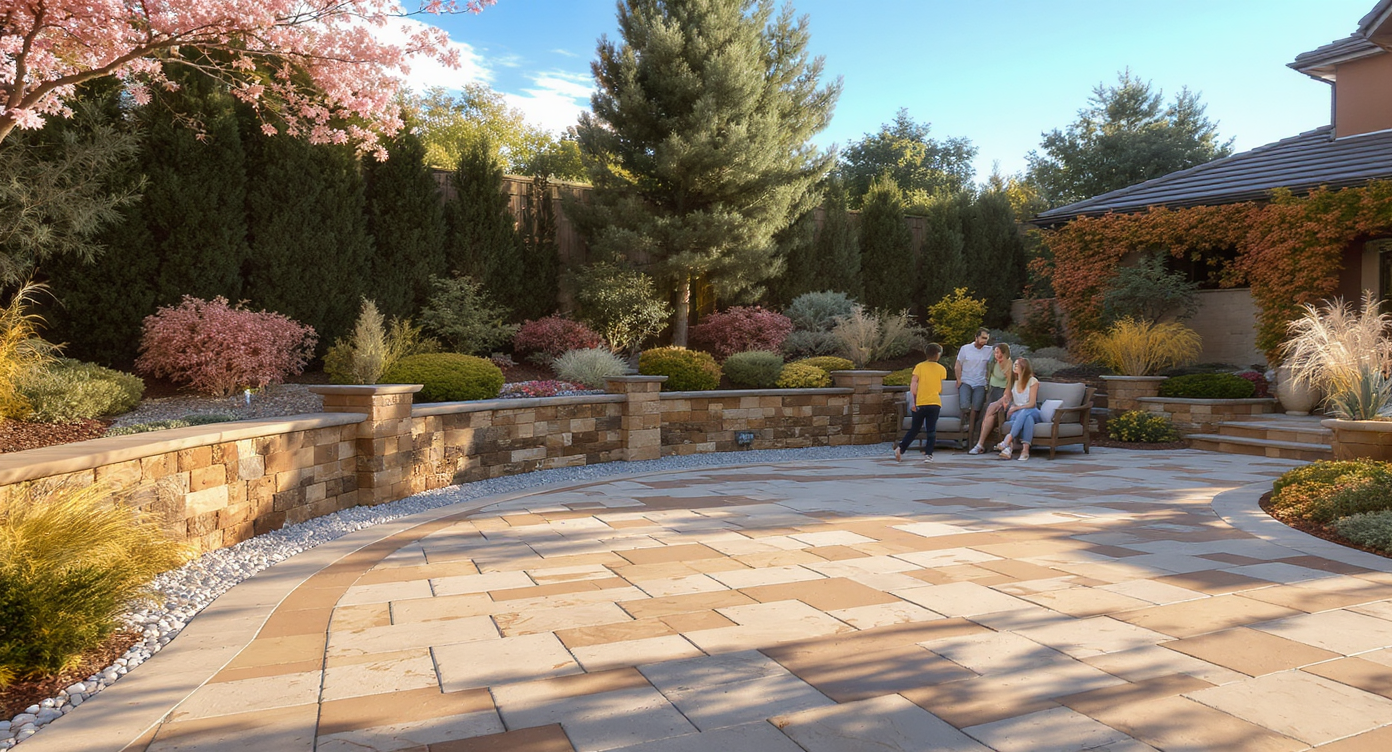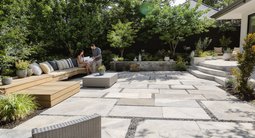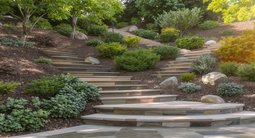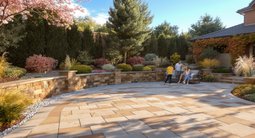TL;DR
For a durable, low-maintenance yard, prioritize hardscaping basics: a compacted base, a 1–2% slope for drainage, and materials suited to your climate. Build paver patios over well-compacted crushed stone, edge paths for clarity, and use polymeric sand to lock joints and block weeds. To preview low-maintenance hardscaping ideas for small backyards, upload a photo to ReimagineHome.ai and compare options side-by-side: https://www.reimaginehome.ai/?utm_source=blog.
Why Outdoor Design and Curb Appeal Matter Right Now

Right-sized paths and hierarchy of materials boost curb appeal and ease of movement at home entrances.
Primary garden paths typically range from 36–48 inches wide for comfortable use. Curb appeal projects that improve entry clarity, lighting, and planting structure can increase perceived value and help homes sell faster. Here’s the featured-snippet version: focus on drainage, right-sized paths, and materials that match your climate. A clean hierarchy—drive, walk, patio—keeps movement obvious, reduces maintenance, and frames planting for four-season interest.
Why Landscaping, Gardening & Hardscaping Are Changing
Hardscape elements often account for 50–70% of a low-maintenance yard budget. That spend goes further when installed correctly: remove organic material, compact the subgrade, add 4–8 inches of crushed stone (more in freeze-thaw zones), screed a thin bedding layer, and set pavers with tight cuts. Climate shifts and water limits are reshaping landscaping ideas. Drought-tolerant planting, rain gardens, permeable pavers, and gravel paths reduce irrigation needs and help with stormwater. Work-from-home living also pushes patios and small seating nooks to the front of the priority list, while homeowners expect crisp detailing—clean curves, tight paver cuts, and long-lasting retaining walls that double as seat walls.
Anecdote
A homeowner with persistent puddles under a shady side gate replaced compacted lawn with a 42-inch gravel path and a perforated drain wrapped in fabric. The path now reads as a clean, modern line, and the gate area stays dry after storms—proof that drainage and clarity beat patchwork fixes.
Key Landscaping & Hardscaping Trends (and How ReimagineHome.ai Shows Them)
Experts recommend a 1–2% slope for patios for proper drainage. That means about 1/8–1/4 inch of drop per foot, directed away from structures and toward drains or permeable zones. - Layered planting and year-round structure - Stone, gravel, and stepping-stone paths - Outdoor rooms, seating pockets, fire pits - Drought-tolerant and native planting layouts - Modern curb appeal changes that boost value Layered planting gives structure in winter and softness in summer. Stone and gravel paths read modern, drain well, and are budget friendly. Outdoor rooms—defined by low walls, planters, or hedges—extend living space without sprawling lawns. Native and climate-adapted plants lower upkeep while feeding pollinators. On the curb, new house numbers, lighting layers, a trimmed planting palette, and a defined walk instantly modernize. Want to try materials before you commit? ReimagineHome.ai previews patio sizes, curves, retaining wall heights, lighting warmth, and planting massing over your own photo so you can compare schemes, from warm-toned gravel and red herringbone pavers to cool gray slabs and basalt edging: https://www.reimaginehome.ai/?utm_source=blog.
How to Use ReimagineHome.ai to Visualize Yards, Paths & Patios
For airflow and maintenance, shrubs should be planted 18–24 inches from foundations. That single offset reduces mildew, preserves siding, and gives you room to prune. 1. Upload a clear exterior or yard photo. 2. Pick a style or function (low-maintenance, modern, family-friendly, drought-tolerant). 3. Test path shapes, patio sizes, steps, seat walls, and gentle terraces (use 6–7 inch risers outdoors). 4. Experiment with planting layers, landscape lighting, and focal points like a fire bowl or water feature. 5. Generate multiple versions and compare before committing—swap materials, adjust slope arrows, and check day/night views in a few clicks.
Real-World Stories — Landscaping & Hardscaping in Action
Thoughtful front yard updates can significantly increase perceived home value. Clean lines, safe lighting, and clear circulation are the fastest wins. - A small urban yard redesigned with raised beds and timber-framed gravel steps gained a usable 60–80 square feet of flat space. The gravel treads drained well in shade, and the pressure-treated frames—set on gravel, not soil—extended longevity while avoiding slick moss. - A seller refreshed curb appeal with a 42-inch-wide front walk, a single material palette (charcoal pavers with steel edging), and warm LED path lights. Result: clearer arrival, fewer trip hazards, and a modern look that photographed beautifully for the listing. - A family yard swapped patchy lawn for a compact paver patio plus a curved seat wall. Using polymeric sand kept weeds down, while the 1–2% patio slope moved stormwater to a dry well—meaning less mud, more play time, and no puddles against the house. Each outcome hinged on scale, drainage, and disciplined material choices—simple decisions with outsized returns.
Visualization Scenario
Upload a photo of your cracked 10×10 concrete pad into ReimagineHome.ai. Test a 12×14 herringbone paver patio with a curved edge, a basalt gravel side path tied into a drain, and a 16-foot planting ribbon of native grasses. Toggle night mode to preview warm step lights and a low-voltage uplight on the maple.
FAQ
- Over-paving or under-paving - Ignoring grading and drainage - Planting too close to structures - Using materials that don't match climate - Insufficient lighting layers Fixes: Right-size paving to activities—add a seating pocket instead of paving the whole yard. Establish slope early; in flat or clay-heavy sites, integrate a drain line, dry well, or permeable joints. Keep shrubs 18–24 inches off walls and 3 feet from AC units. Choose freeze-thaw–rated pavers in cold zones and lighter stone or permeable gravel in hot-dry climates. Layer lighting—ambient (posts/walls), task (steps), and accents (uplights). ReimagineHome.ai helps you test path widths, slope directions, and night-lighting layouts before you order a single pallet: https://www.reimaginehome.ai/?utm_source=blog.
Visualize Your Home’s Next Chapter
Over half of first-time projects underestimate walkway widths. Plan for two people to pass (36–48 inches), edge paths to contain gravel, and size patios for furniture plus circulation (10–12 feet minimum diameter for four chairs around a fire pit).
.svg)

.svg)













.png)